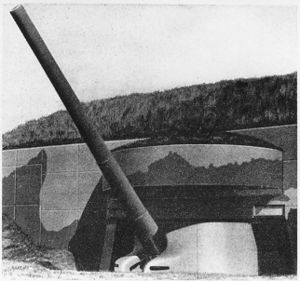Fort Duvall facts for kids
Quick facts for kids Fort Duvall |
|
|---|---|
| Part of Harbor Defenses of Boston | |
| Spinnaker Island (formerly Hog Island), Hull, Massachusetts | |

A 16-inch casemated gun, similar to those at Fort Duvall
|
|
|
Location in Massachusetts
|
|
| Coordinates | 42°18′0.36″N 70°53′45.17″W / 42.3001000°N 70.8958806°W |
| Type | Coastal Defense |
| Site information | |
| Owner | Spinnaker Island and Yacht Club |
| Controlled by | private/Town of Hull |
| Open to the public |
no |
| Site history | |
| Built | 1920-1927 |
| Built by | United States Army |
| In use | 1927-1948 |
| Battles/wars | World War II |
Fort Duvall was a special fort built to protect the coast, part of the defenses for Boston Harbor in Massachusetts. The U.S. government bought Hog Island (now called Spinnaker Island) in Hull, Massachusetts, in 1917. The fort was built there in the early 1920s.
It only had one main gun area, called Battery Long. But it had the biggest guns in the whole defense system: two giant 16-inch guns! These specific guns were called the 16-inch gun M1919. Only seven of these were ever used. Later, the Navy provided other 16-inch guns.
Contents
What Was Fort Duvall?
Fort Duvall was a very important part of protecting Boston during wartime. It was designed to stop enemy ships from getting close to the city. The fort's powerful guns could shoot very far. They could cover a huge area from Gloucester in the north to Plymouth in the south. They could also reach far out into the ocean.
Why Was It Built?
Around 1920, military planners thought about putting a huge 16-inch gun battery on other islands. These included the Brewster Islands Military Reservation and the Calf Island Military Reservation. They even thought about using a twin naval-style gun turret. However, they decided to build Fort Duvall on Hog Island instead.
Who Was William Penn Duvall?
In 1922, the fort was named after Major General William Penn Duvall (1847-1920). He was a graduate of West Point, a famous military academy. Duvall was born in Maryland. He was a key helper to the Army's Chief of Artillery. He also served twice in the Philippines, once as the commander of all Army troops there. He was known for being fair and balanced in how he managed the islands.
How the Fort Worked
Fort Duvall was hidden behind a hill at Point Allerton. This meant enemies at sea could not see the fort. To aim the guns, soldiers used a tall fire control tower at Point Allerton. This tower is still standing today (as of 2016) and is privately owned.
Protecting the Guns
When Battery Long was first built, its guns were out in the open. But in 1942, during World War II, they were put inside strong concrete shelters called casemates. This was done to protect them from air attacks.
At the time, the next biggest guns were 12-inch guns at Battery Gardner, located at Fort Ruckman in Nahant, Massachusetts. Later, two more 16-inch guns were added in Nahant at Battery Murphy. Another pair of 16-inch guns was planned for Fort Dawes on Deer Island. The places for these guns were built at the start of World War II, but the actual gun barrels never arrived.
Because Fort Duvall had such powerful 16-inch guns, many older, less powerful guns were removed. This included many 10-inch and 12-inch batteries. For example, the batteries at Fort Revere in Hull, which was just north of Fort Duvall, were removed. All of the 12-inch coast defense mortars were also taken out of service and scrapped.
Fort Duvall After the War
In 1948, Fort Duvall's huge guns were scrapped, meaning they were taken apart and recycled. The Army kept the island. From 1952 to 1955, the island had a battery of four 90 mm anti-aircraft guns. These guns were used to shoot down enemy planes.
From 1956 to 1974, the fort was used as a control center for Nike missiles. The actual missile launch site was at Webb Memorial State Park in Weymouth. In 1974, the island was given to the state of Massachusetts. It was used to store school textbooks for a while. Later, it was sold to private owners and developed into a gated community.
Images for kids
-
A 2010 view, looking westward at Hog Island, the site of Fort Duvall. Later the site was purchased, covered with condominiums, and renamed Spinnaker Island. The arrow points to the casemate of Gun 2 of Battery Long, which is now a parking garage.








